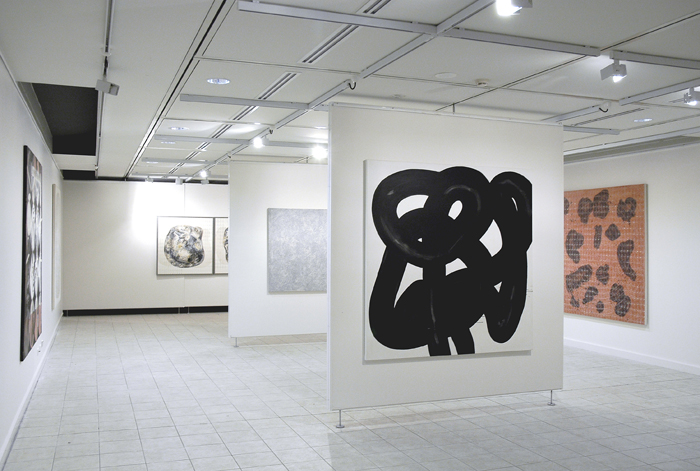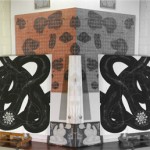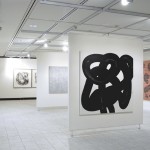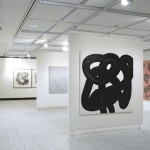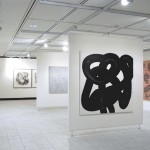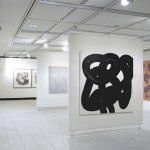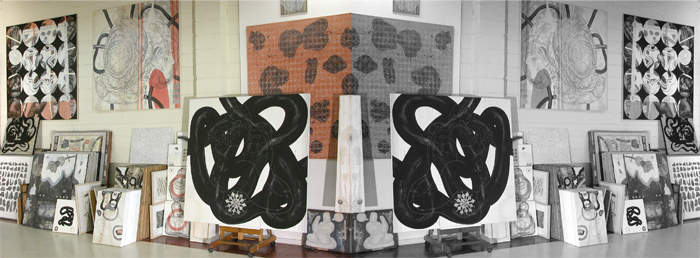
Catalogue essay by John Conomos, June 2012
Terry Burrows’s engaging new exhibition “Now & Then” is aptly named as it displays a variety of works that scan virtually a decade in the artist’s art and career. It is, strictly speaking, not a “survey show” as such but rather it delineates certain unifying themes, forms and interests germane to Burrows’s highly experimental and poetic drive to create work that is outside the ongoing critical fashions of the contemporary art world. Burrows is, above all, true to his calling as an artist who is faithful to his searching idiosyncratic “inner vision” of someone who weaves his compelling surreal, semi-figurative, dark and, at times, playful images across several art forms – painting, photography, installation and sculpture. This exhibition, on a fundamental conceptual and formal level, clearly indicates that Burrows’s art represents, in Jean-Louis Schefer’s telling phrase, a hybrid form of “aesthetic vagabondage.”
Most of the multifaceted paintings in the exhibition display Burrows’s impressive and imaginative quest to produce works that are organically connected to each other in their overall studio context. In this critical sense, “Now & Then” represents a fine body of work that acutely reverberates on several aesthetic, cultural and cross-disciplinary registers common to Burrows’s overriding concern with human communication as an expression of dialogue, intrigue, play, touch and sex. Further, Burrows’s inventive project to create paintings of subtle figuration and abstraction that are based on ideas, forms and techniques emanating from Western and Asian art, culture and philosophy is crucially predicated on his desire to italicise the poetry of communication.
Relatedly, Burrows’s gestural works also exhibit an underlying interest in generating a phenomenological “floating world” aesthetic of figures, forms and contexts that speak of his symbolic and spiritual interests in showing us the absurd and lyrical aspects of our desire to communicate to each other, individually and socially, in our passage through the random flux of life. Burrows’s vision has a quiet surreal humour to it in that it denotes, like we see in Michelangelo Antonioni’s splendid modernist cinema, the existential limits of human communication. For Burrows, humans create their own barriers to communication to each other as much as they desire to, as the old American Bell Telephone advertisement puts it, “reach out and communicate” with each other. Incommunicability is an integral part, as Antonioni’s films show, of human communication.
Intertwined abstract black and white figures float in a void of ambiguity, angst, humour and sex. Weird surreal bodies feature in these intriguing works of glazed colours, abstract expressionist lines, gestures and contexts. Copulating figures, amputated figures, figures locked in the see saw of eros and thanatos. Images that evoke the Surrealist’s idea of “the informe.” The universe forged on the anvil of chance, desire and laughter. Or, if you will, Burrows’s enigmatic paintings also suggest the absurd darkness of David Lynch’s post-Norman Rockwell cinema of deep-seated, unsettling “psychic plumbing.” (The vivid expression once used by David Lynch to describe his cinema.)
Burrows’s open-ended works are, in certain critical respects, indebted to the traditional ideas of Hindu and Buddhist Tantric art. For the artist, human interaction is shaped by conversation as much as by sex and ritual as much as by touch. The colours preferred by Burrows are glazed in character, usually black, white, yellow and red. Burrows has never been interested in the different visual effects generated by the use of many different colours, instead, he is concerned with colours that are quite graphic and iconic in their effect. Colours that are more at home with cartoons, comics, and basic graphic design. Burrows prefers the cartoon world of black and white, and also the expressionist forms of calligraphy. His paintings possess certain fundamental tropes that are in tune with Abstract expressionism, black and white animation cartoons, and Surrealism. In other words, Burrows has produced works that dance with the zig-zag hybrid concepts, gestures, lines and nuances of colliding art forms and genres from the West with the East. The thematic and formal underpinnings of the artist’s paintings suggest a subtle, creative and well-informed familiarity with these different artistic, cultural and generic influences.
Consequently, there are in Burrows’s work abstract forms that represent a semiotics of gestures, energy and passion: a narrative collage of absences and presences, of non-communication and memory. Paintings whose formal and spatial configurations suggest the centrality of drawing as a key creative metaphor that informs Burrows’s art in general. Drawing, in the sense, that enables the artist to utilise bold lines, colours and textures in a dynamic “intertextual” manner: suggestive of looking beyond the “ghetto” boundaries of different art forms in order to explore complex ideas of human existence, time and space.
One can discern in Burrows’s exhibition the shadow of artists like Paul Klee and, in terms of the Asian influence of Buddhism and Tantric art, Henri Michaux comes to mind. There is a certain affinity between Burrows’s archetypal characters and their interior landscapes as an expression of expressionist, playful drawing and Michaux’s bold white and textual drawings of inner trance-like states of human perception.
“Now & Then” is a notable testament to Burrows’s continuing and uncompromising exploration of painting as an existential and experimental adventure in attempting to find a new path to art and authenticity.
